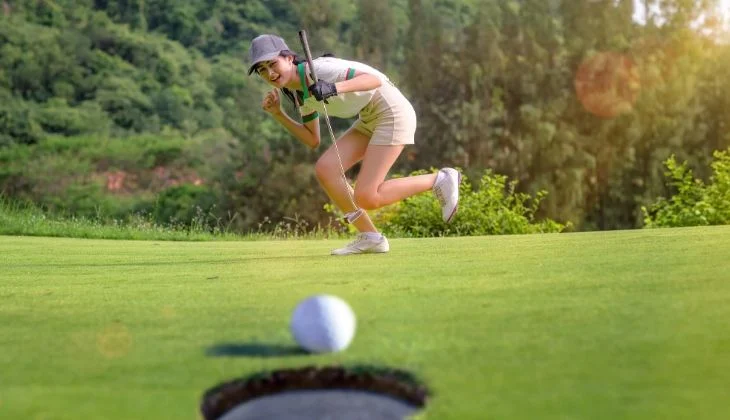How to improve your putting in golf is not something you will learn by watching videos or articles on the internet. However, we can give you a guide for when you decide to get going and go to your club or practice facility.
Alignment and posture
Correct positioning of the body, feet, and club relative to the ball and the intended line of the putt is essential for consistency and accuracy. A good practice routine should include a specific focus on body alignment and hand and arm position to promote a consistent and repeatable putting motion.
Another key aspect is the stance. He stance of the golfer can significantly influence the stroke of the putt. It is important to maintain a stance stable and balanced throughout the stroke, with a slight bend in the knees and a straight back. The position of the eyes in relation to the ball is also a crucial part of the stance, given that The player must ensure that the eyes are directly on the ball to have a clear and precise view of the intended shooting line.
Have a good grip and control of the stick
He grip Club control is essential for a successful putting technique. grip should be firm but relaxed, with the hands working together to maintain control and stability throughout the stroke. One of the grip common and effective is the grip reverse overlap, in which the golfer's dominant hand (the right hand for right-handers) slightly overlaps the fingers of the leading hand, which helps to encourage a smooth, consistent stroke. The putter is the most personal stickl in your golf bag, and it is important that you have your length measurement and the grip that makes you feel more comfortable.
When it comes to controlling the club, the golfer must focus on use the larger muscles of the shoulders and back to create a pendulum-like motion with the putter. This helps reduce the influence of the hands and wrists on the stroke, promoting a more consistent and reliable putting action. Combined with a good grip, proper club control can make a significant difference in accuracy and feel.
Work on rhythm and feel to improve your golf putting
Rhythm plays a vital role When putting, developing a smooth and consistent rhythm can greatly improve a golfer's ability to control distance and direction. The ideal stroke is one that flows effortlessly, and finding the right rhythm can help achieve this. A good way to work on rhythm is through practice drills that focus on the rhythm and timing of the putting motion, helping the golfer develop a natural and reliable feel for distance control.
In addition to rhythm, focusing on the feel of movement is essential. Golfers must pay attention to the feedback they receive from the clubface and the sound of the ball at impact to develop a keen sense of ball movement. By concentrating on the subtle sensations of a well-struck putt, you can train yourself to consistently reproduce that feeling, leading to improved performance on the green.

Distance and accuracy drills
An effective exercise is to place tees or small targets at different distances on the green and practice putting toward those targets. This not only helps improve accuracy, but also helps develop a keen sense of distance control, which is crucial for long-distance putting.
Another valuable exercise is to practice on specific holes with varying degrees of slope. This helps golfers sharpen their ability to read the green and anticipate the bump and the speed of the ball.
Always aim with your eyes on the target
A fundamental but often overlooked aspect of putting is the importance of aiming with the eyes. Golfers must train themselves to focus intently on the intended line of shot, as the eyes are a crucial reference point for putting. Align the putt and calculate the desired lineBy maintaining a steady, unwavering gaze on the target with their eyes, golfers can improve their ability to consistently start the ball on the intended line, a key factor in putting success.
In addition to initial aim, it is beneficial for golfers keep your eyes fixed on the back of the ball throughout the putting motion. This concentration and visual control contribute to a more stable and controlled putting motion, ultimately leading to greater accuracy and consistency on the greens.
Read carefully the slopes and the unevenness of the green
Understanding the slopes and slants of the green is a skill that distinguishes good golf putters from the rest. Take the time to carefully read and analyze the contours of the green, identifying the subtle slopes and slants that will influence the trajectory of your putts. By developing a keen awareness of the green's topography, you can make more informed decisions about line, speed, and putting.
An effective way to practice reading the green is to spend time watching the ball roll. from different angles around the holeThis way, you can gain valuable insight into the nuances of the green and develop a better understanding of how putts will react to different slopes and angles, improving your ability to anticipate and adjust to these factors during the actual round.
Make consecutive sets of putts to increase confidence
Increasing confidence in putting is just as important as mastering the technical aspects of the movement. A very effective exercise to increase confidence on the greens is to practice series of consecutive putts at different distancesBy consecutively making putts of different lengths and positions, you can instill a sense of satisfaction and develop a positive and confident mental attitude during the actual round.
Consistently practicing series of putts also helps refine the mental aspect, allowing you to focus on the process of making a smooth, confident swing without being distracted by past results. This mental toughness and confidence-building exercise can significantly benefit a golfer's putting performance under the pressure of a competitive round.

Practice putting on a variety of surfaces
Additionally, practicing on different surfaces, such as fast and slow greens, can provide valuable experience in adjusting to the speed and grain of the putting surface. This type of diverse practice helps golfers feel more comfortable and confident when faced with unfamiliar green conditions, ultimately improving their overall skills and performance on the course.
Strive to repeat the correct movement
Consistency is key in putting, and striving to repeat the correct motion is essential to developing reliable and effective putting technique. This includes keeping your head in a fixed and stable position, a smooth and continuous motion, and consistent acceleration through the ball.
By consistently reproducing the proper putting motion, you can develop muscle memory and reinforce the foundation of solid putting technique. This leads to Greater precision, control and confidence on the greens.






